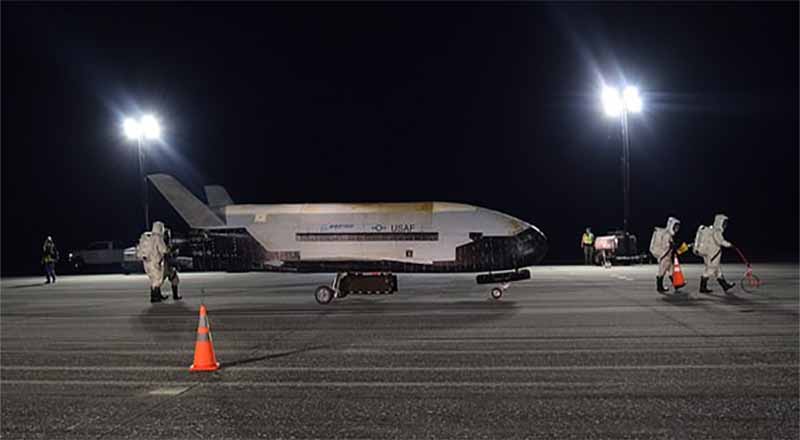U.S. Air Force X-37B space plane, an unpiloted miniature space shuttle, is seen after landing at NASA’s Kennedy Space Center Shuttle Landing Facility on Oct. 27, 2019 to end its record 780-day OTV-5 mission.
The U.S. Air Force’s unpiloted X-37B space plane landed back on Earth Sunday (Oct. 27) after a record 780 days in orbit , racking up the fifth ultra-long mission for the military’s mini-shuttle fleet.
X-37B vehicles are 29 feet (8.8 meters) long, 9.5 feet (2.9 m) tall and have a wingspan of just under 15 feet (4.6 m). Their payload bays are about the size of a pickup truck bed, about 7 feet long and 4 feet wide (2.1 by 1.2 m).
The X-37B’s Orbital Test Vehicle 5 (OTV-5) mission ended with a smooth autonomous touchdown at the Shuttle Landing Facility of NASA’s Kennedy Space Center in Cape Canaveral, Florida at 3:51 a.m. EDT (0751 GMT), Air Force officials said. The mission originally launched on a SpaceX Falcon 9 rocket on Sept. 7, 2017.
With the successful landing, OTV-5 broke the previous X-37B mission record of 718 days set by the OTV-4 mission in May 2017. OTV-5 is the second X-37B mission to land at NASA’s Shuttle Landing Facility (OTV-4 was the first), with previous missions landing at Vandenberg Air Force Base in California.
“The safe return of this spacecraft, after breaking its own endurance record, is the result of the innovative partnership between Government and Industry,” Air Force Chief of Staff Gen. David L. Goldfein said in a statement. “The sky is no longer the limit for the Air Force and, if Congress approves, the U.S. Space Force.”
The U.S. Air Force has at least two reusable X-37B spacecraft in its fleet, and both have flown multiple flights. The solar-powered space planes were built by Boeing and feature a miniature payload bay to host experiments or smaller satellites. They were originally designed to spend up to 240 days in orbit.
“The X-37B continues to demonstrate the importance of a reusable spaceplane,” said Secretary of the Air Force Barbara Barrett said in the same statement. “Each successive mission advances our nation’s space capabilities.”
Air Force officials have said that the exact nature of X-37B missions are classified, though they have dropped hints about the types of experiments OTV-5 performed in orbit. One payload was the Air Force Research Laboratory Advanced Structurally Embedded Thermal Spreader, an experiment designed to “test experimental electronics and oscillating heat pipe technologies in the long-duration space environment,” according to an Air Force statement.
OTV-5 also flew to a higher-inclination orbit than previous X-37B flights, suggesting it had new experiments or technology tests in store. In a statement today, Air Force officials confirmed OTV-5 carried multiple experiments and carried smaller satellites into orbit.
“With a successful landing today, the X-37B completed its longest flight to date and successfully completed all mission objectives,” Randy Walden, Air Force Rapid Capabilities Office director, said in the statement. “This mission successfully hosted Air Force Research Laboratory experiments, among others, as well as providing a ride for small satellites.”
The X-37B space plane was originally developed by NASA in 1999 to serve as a technology test bed for future spacecraft and looks much like a miniature version of a space shuttle. In 2004, the military’s Defense Advanced Research Agency (DARPA) took over the project, ultimately turning it over to the U.S. Air Force’s Rapid Capabilities Office a few years later.
The first X-37B mission, OTV-1, launched in April 2010 and spend 224 days in orbit. OTV-2 launched in March 2011, marking the first flight of a second X-37B, and stayed in orbit for 468 days.
OTV-3 marked the first reflight of an X-37B (using the OTV-1 vehicle) and launched in December 2012 on a 674-day flight. The OTV-4 mission launched in May 2015 (the second flight of the OTV-2 vehicle) and spent 718 days in space. The first four OTV missions launched on Atlas V rockets, with OTV-5 marking the fleet’s first use of a SpaceX Falcon 9.
“This spacecraft is a key component of the space community. This milestone demonstrates our commitment to conducting experiments for America’s future space exploration,” said X-37B program manager Lt. Col. Jonathan Keen in the Air Force statement. “Congratulations to the X-37B team for a job well done.”





